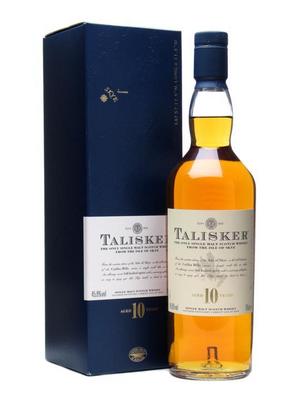|
|
Release Notes
A massive success as the island representative in Diageo's "Classic Malts" series, Talisker's profile keeps increasing as more fans discover its intense coastal spicy, peaty character. A truly elemental malt.
The Whisky Exchange
3rd Party Tasting Notes
Nose: Fruity and sweaty. Some organics. A malty component as well. Opens up after some breathing. A hint of rotting milk powder - and yes, I realise that this is a fragrance outside most people's experience ;-) Oddly oily for a Talisker 10yo; I never found any oil in Talisker before as far as I know. Some cardboard.
Taste: Sweet. Some fairly faint smoke and organics, evolving into peat.
Very subtle fruits in the finish.
Score: 83 points - which is a little below earlier batches, but still very respectable for a 10yo whisky.
Taste: Sweet. Some fairly faint smoke and organics, evolving into peat.
Very subtle fruits in the finish.
Score: 83 points - which is a little below earlier batches, but still very respectable for a 10yo whisky.
Malt Madness
A recent version that I reduced to 40% a.b.v. for the purpose of this unusual head-to-head session.
Colour: pale gold.
Nose: rather maritime right at first nosing, with the usual mix of peat smoke, wet hay, oysters and pepper (not an extreme pepper here). It gets then rather waxy, with also quite some beer (quite mashy!), porridge, boiled cereals and fermented barley.
Mouth: it starts much more peppery this time, with lots of spices and quite some oak. Maybe it's a little harsher, less rounded that some earlier versions, and it gets extremely herbal after a moment (parsley, mustard seeds) with also quite some iodine, salt, getting frankly 'seawatery'. Almost no fruits and no sweetness except, maybe, hints of dried pears.
The finish is long, extremely peppery and very, very dry, with a lot of persistence.
No smoothness at all in this very austere version for big boys, that's sharp like a blade - but again, I like this kind of rather extreme profile a lot.
88 points.
Colour: pale gold.
Nose: rather maritime right at first nosing, with the usual mix of peat smoke, wet hay, oysters and pepper (not an extreme pepper here). It gets then rather waxy, with also quite some beer (quite mashy!), porridge, boiled cereals and fermented barley.
Mouth: it starts much more peppery this time, with lots of spices and quite some oak. Maybe it's a little harsher, less rounded that some earlier versions, and it gets extremely herbal after a moment (parsley, mustard seeds) with also quite some iodine, salt, getting frankly 'seawatery'. Almost no fruits and no sweetness except, maybe, hints of dried pears.
The finish is long, extremely peppery and very, very dry, with a lot of persistence.
No smoothness at all in this very austere version for big boys, that's sharp like a blade - but again, I like this kind of rather extreme profile a lot.
88 points.
Whisky Fun
Nose: Wonderful aroma. Pungent, smoke-accented, rounded.
Palate: Full maltiness, slightly syrupy, with sourness and a very big pepperiness developing.
Finish: Very peppery, huge, long.
Comment: Always a classic, though I still miss the 8 Years Old.
Rating: 9/10
Palate: Full maltiness, slightly syrupy, with sourness and a very big pepperiness developing.
Finish: Very peppery, huge, long.
Comment: Always a classic, though I still miss the 8 Years Old.
Rating: 9/10
Michael Jackson, Whisky Magazine #5
Nose: A razor-sharp spiciness lances through Demerara sweetness and rich peat. Absolutely magnificent.
Palate: The enormous build up of spice adds to the multi-layered peat. The sweetness is almost like freshly crushed grist. Wave upon wave, layer upon layer of complexity.
Finish: Massively warming and still spicy. The peat lingers while the spice bristles.
Comment: A dram to be savoured and celebrated.
Rating: 9.5/10
Palate: The enormous build up of spice adds to the multi-layered peat. The sweetness is almost like freshly crushed grist. Wave upon wave, layer upon layer of complexity.
Finish: Massively warming and still spicy. The peat lingers while the spice bristles.
Comment: A dram to be savoured and celebrated.
Rating: 9.5/10
Jim Murray, Whisky Magazine #5
Nose: Beeswax. Old furniture. Black pepper. Boat rope. Wet sand. Touch of seaweed. Crisp bacon. Gooseberry.
Palate: Sweet at start then slightly bitter. Wood comes quickly through. Smoked meat. Smoked almonds.
Finish: Sweet and spicy. Dry.
Comment: Less peppery than in my memory. As if the spicy outburst on mid palate has been tamed. A bit harsh too. Seems to have lost its volcanic temper.
Rating 7.5/10
Palate: Sweet at start then slightly bitter. Wood comes quickly through. Smoked meat. Smoked almonds.
Finish: Sweet and spicy. Dry.
Comment: Less peppery than in my memory. As if the spicy outburst on mid palate has been tamed. A bit harsh too. Seems to have lost its volcanic temper.
Rating 7.5/10
Martine Nouet, Whisky Magazine #45
Nose: Fishboxes, pier heads, light smoke. Somewhat reminiscent of a manzanilla pasada: green olive and saltiness (oh yes there is) albeit with smoke. Yeasty, vibrant, heathery, fresh.
Palate: Fresh. Marine notes. Immediate smoke, leading to a sweet, lightly oily centre. White pepper.
Finish: Vibrant, prickly. Turfy.
Comment: Elemental. Another classic...
Rating: 8.25/10
Palate: Fresh. Marine notes. Immediate smoke, leading to a sweet, lightly oily centre. White pepper.
Finish: Vibrant, prickly. Turfy.
Comment: Elemental. Another classic...
Rating: 8.25/10
Dave Broom, Whisky Magazine #45
The Distillery: Talisker
| Established: 1830 |
| Silent since: False |
| Address: Carbost, Isle Of Skye IV47 8SR, UK |
| → website |
During the 1990"s Talisker was usually one of the first single malts that a relative malt whisky novice would get to try. As part of Diageo"s series of six "Classic Malts" (along with Cragganmore, Dalwhinnie, Glenkinchie, Oban and Lagavulin on Islay) it was one of the few Scotch single malts that could be found on the shelves of almost every reasonably stocked liquorist.
Roderick Kemp sold his share of Talisker in 1892 and used the proceeds to buy Macallan. Ownership of Talisker kept changing in the decades after that, until DCL took control in 1916. The method of triple distillation that was traditionally employed at Talisker was abandoned in 1928. After administration of the distillery was transferred to Scottish Malt Distillers (SMD, predecessors of Diageo) in 1930, things quieted down for a while at Talisker for a few decades. However, in 1960 there was a large fire at the distillery. Talisker was closed for two years, during which time they commissioned the construction of identical copies of the five stills that were damaged or destroyed in the fire.
Talisker re-opened its doors in 1962 and proceeded as before until 1972. At that point the malting at the distillery stopped. From then on the barley was malted at the Glen Ord Central Maltings in the Highlands.
Talisker was built in 1830 by brothers Kenneth and Hugh MacAskill. As sons of the local doctor they were part of the establishment, so it"s unlikely they would have embraced the fine art of distillation so bravely if it had still been an illegal practice. But for those that took the trouble of obrtaining a license it wasn"t anymore, so distillation at Talikser was started in 1831. Everything proceeded smoothly for two decades, but in 1848 they passed the lease of Talisker on to North of Scotland Bank.
The bank didn"t hold on to the distillery for more than a decade; they sold it on to Donald McLellan in 1857 for a mere 500 GBP. Despite the relatively modest investment Donald had problems making Talisker turn a profit, so in the 1860"s John Anderson became involved. After he was imprisoned for selling casks of whisky that never really existed (fraud apparently wasn"t invented in the 1900"s) it was time for new owners for the Talisker distillery; Roderick Kemp and Alexander Grigor Allen.
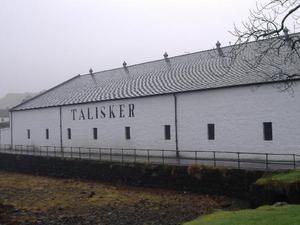
Together with Lagavulin, Talisker represented a heavier side of the single malt spectrum. Their barley (which is malted at Glen Ord) isn"t as peaty as Lagavulin"s (the Talisker "recipe" requires a peating level of +/- 22 PPM) but the whisky still makes a strong impression on most novices in the world of single malt Scotch. This was especially true in the 1990"s when Islay malts like Ardbeg and Caol Ila were not available as proper single malt "brands".
The remote island of Skye has many similarities with Islay - for one thing its Hebridean climate. Nevertheless, it"s usually classified as an "Island" whisky, which most experts consider to be part of the "Highlands" region. This means that Talisker is grouped together with a mish-mash of other malt whisky distilleries which have very different profiles, including Arran, Highland Park, Jura, Scapa and Tobermory. The distant location of Talisker was not chosen because that made the distillery hard to find for excise men that roamed the land in the illustrious illegal days of Scotch whisky. When the distillery was built in 1831 the whisky business had just turned legitimate - less than a decade earlier George Smith had just obtained the first proper license to distill whisky at Glenlivet distillery.
In 1988 Diageo launched the aforementioned "Classic Malts Selection" and a decade later they joined the finishing bandwagon with "double matured" expressions of their six classic malts. The "Distillers Edition" of Talisker was enhanced with a amoroso sherry finish. Over the years a number of limited editions was released and in 2004 Talisker expands the range with an 18yo expression (shown at the left) as well as a 25yo bottling.
In 2005 Talisker distillery celebrated its a birthday and released the "175th Anniversary" without an age statement. This was hardly a "limited edition"; some 60,000 bottles were produced. At the same time they launched another 25yo expression (the third edition).
2006 - The official Talisker range is expanded further with a 30yo OB - the oldest official bottling so far,
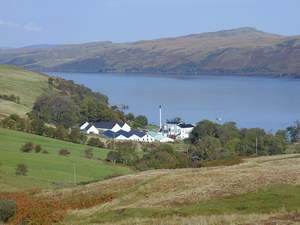
2008 - Yet another new bottling is added to the range; the Talisker NAS "57° North" (57%, OB, Bottled 2008).
A 30 years old bottling was first released in 2006, as well as another edition of its 25yo expression. These bottlings may not seem that old compared to releases in the ranges of Macallan or Dalmore, but for Talisker it was a significant departure. For the first ten years of the "Classic Malts Selection" only the 10yo standard bottling was available and after the "Distillers Edition" became available in 1998 they didn"t release any older expressions for a few years. So, older OB"s of Talisker are a fairly new phenomenon.
In the new Millenium
2004 - The range of official bottlings of Talisker is expanded with 18yo and 25yo expressions.
2005 - a "175th Anniversary" version without an age statement is released.
Trivia:
- Both Johnnie Walker whisky and Drambuie liqueur use Talisker as a component of their blended drinks; its presence is most notable in Walker"s Green Label 15 Year Old Vatted Malt.
- Talisker was the favourite whisky of writers Robert Louis Stevenson and Henry Vollam Morton. In his poem, The Scotsman"s Return From Abroad, Stevenson mentioned "The king o" drinks, as I conceive it, Talisker, Isla, or Glenlivet."
- Talisker was part of Diageo"s original series of six "Classic Malts", together with Cragganmore, Dalwhinnie, Glenkinchie, Lagavulin and Oban. This series was first released in 1988. Around 2005 a bunch of other distilleries were added to the range; Caol Ila, Cardhu, Clynelish, Glen Elgin, Glen Ord, Knockando and Royal Lochnagar.
from Malt Madness
The Owner: Diageo
| Established: 1997 |
| Silent since: False |
| Address: 8 Henrietta Place, London, W1G ONB, UK |
| → website |
Diageo also distributes Unicum, its lighter-bodied variant Zwack and Jose Cuervo tequila products in North America. However, Cuervo operates as a separate company in Mexico and is not owned by Diageo. Similarly Grand Marnier is distributed by Diageo in many markets, including exclusively in Canada, and a deal was reached in 2009 to significantly expand this partnership in Europe.
Furthermore, Diageo owns the Gleneagles Hotel.
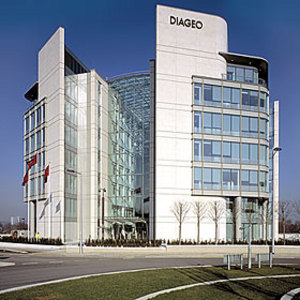
Diageo was formed in 1997 from the merger of Guinness plc and Grand Metropolitan plc. The creation was driven by the two executives Anthony Greener and Philip Yea at Guinness plus George Bull and John McGrath of Grand Metropolitan. The product portfolios of Guinness and Grand Met were largely complementary with little overlap.
Diageo is the world"s biggest whisky producer with 28 malt distilleries and two grain distilleries.The company operates the Scotch whisky distilleries of Auchroisk, Benrinnes, Blair Athol (situated at Pitlochry), Caol Ila, Cardhu, Knockando, Glen Elgin, Clynelish, Cragganmore, Dalwhinnie, Glenkinchie, Glen Ord, Lagavulin, Oban, Royal Lochnagar, Strathmill, Talisker, Teaninich, Mannochmore, Mortlach and Glenlossie, which are sold not only under their own name but used to make the various blended scotch whiskies sold by the company, and owns the stock of many closed distilleries such as Port Ellen, Rosebank, Brora, Convalmore, Glen Albyn, North Brechin, Banff, and Linlithgow. The company have opened a new malt distillery adjacent to their maltings at Roseisle (1st new make spirit produced Spring 2009). This will be one of the largest malt distilleries in Scotland. The new building contains 14 traditional copper pot stills. An expansion programme is also underway at its Cameron Bridge Grain Distillery in Fife that will make it the largest grain distillery in Scotland. Diageo also owns the Port Dundas Grain Distillery in Glasgow, and jointly operates the North British Grain Distillery in Gorgie, Edinburgh, with The Edrington Group.
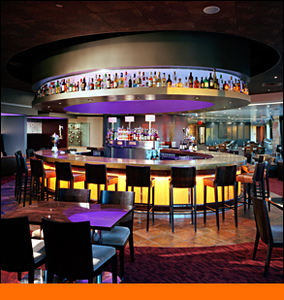
Diageo plc (LSE: DGE, NYSE: DEO) is the largest multinational beer, wine and spirits company in the world. The company is listed on the London Stock Exchange and has American Depositary Receipts listed on the New York Stock Exchange. The word Diageo was formed from the Latin dia (day) and the Greek geo (World), symbolising the use of the company"s brands every day, everywhere. Its head office is located in the City of Westminster in London. It is a constituent of the FTSE 100 Index.
Trivia:
- In December 2003, Diageo provoked controversy over its decision to change its Cardhu brand Scotch whisky from a single malt to a vatted malt (also known as a pure malt) whilst retaining the original name and bottle style. Diageo took this action because it did not have sufficient reserves to meet demand in the Spanish market, where Cardhu had been successful. After a meeting of producers, Diageo agreed to make changes.
- In 2006, the Cardhu brand quietly changed back to being a single malt.
- In July 2009, Diageo announced that, after nearly 200 years of association with the town of Kilmarnock, they would be closing the Johnnie Walker blending and bottling plant as part of restructuring to the business. This would make 700 workers unemployed and caused outrage from press, local people and politicians. A campaign against this decision was launched by the local SNP MSP Willie Coffey and Labour MP Des Browne. A petition was drawn up against the Diageo plans, which also involves the closure of the historic Port Dundas Grain Distillery in Glasgow.
- In February 2009 it was reported in the Guardian that the company had restructured itself so as to avoid paying tax in the U.K., despite much of its profits being generated in the U.K.
- Diageo is engaged in a tax scheme in the United States of America, commonly referred to as the "Rum Bailout", which will guarantee it USD$3 billion in revenues and profits.
- The National Puerto Rican Coalitionplans to run a series of ads in New York City and Puerto Rico urging a boycott of Diageo-owned alcoholic drinks to protest the giant British-owned corporation"s controversial production move of its Captain Morgan rum from Puerto Rico to the U.S. Virgin Islands.
from Wikipedia
